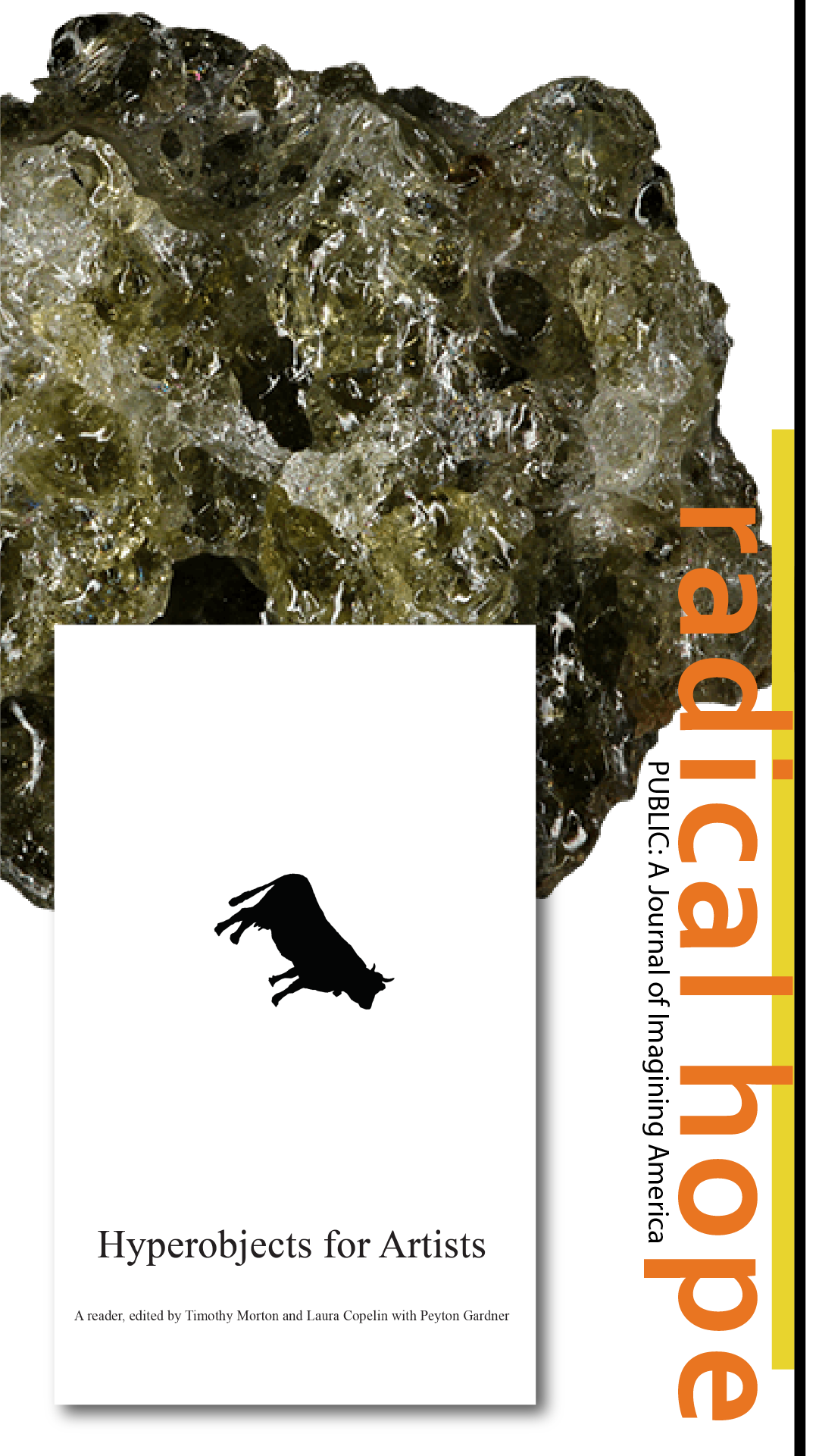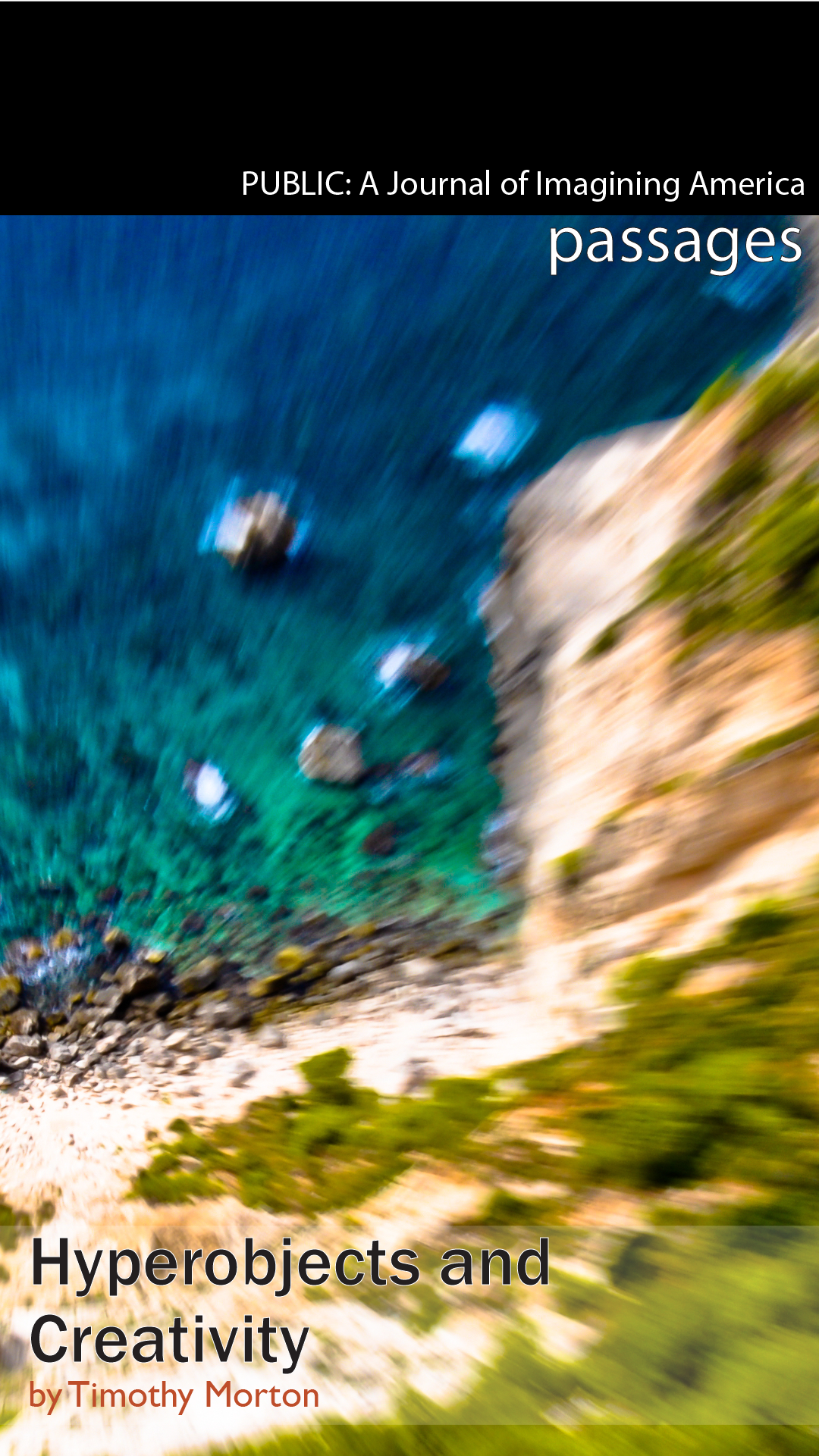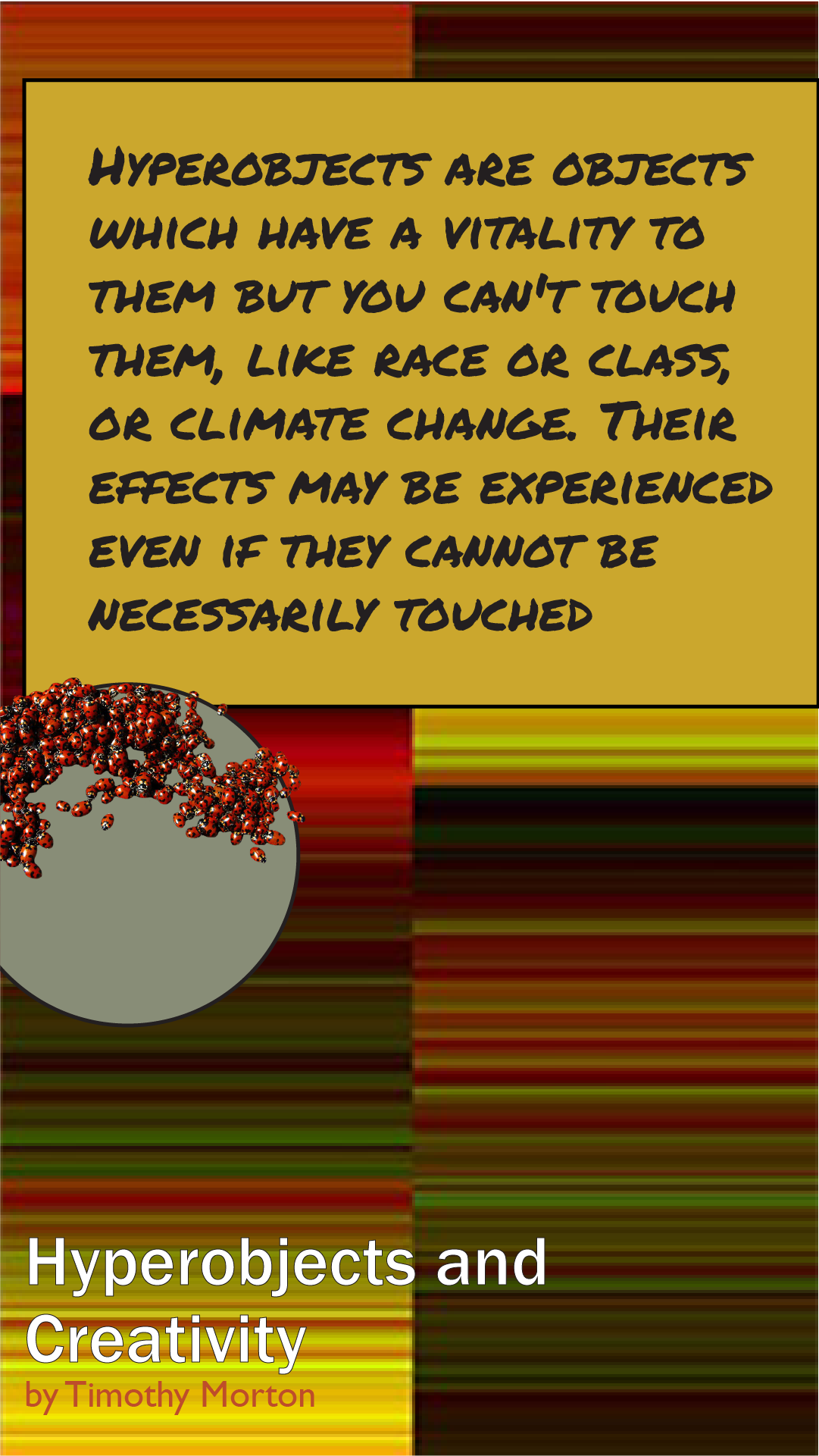Timothy Morton's
Hyperobjects and Creativity
From the editors:
We’re interested in how you’ve described global warming’s many impacts to yourselves, parents, and friends. But we’re most eager to learn what your children are feeling and expressing. They are our “radical” hope.
Those of us who were glued to TV screens during the bombing of the Pacific’s Bikini Islands have retained that haunting, weird, apocalyptic experience. The sheer magnitude of the mega-mushroom cloud imprinted feelings of awe and dread, death and foreboding. At the same time, some of us were watching the The Twilight Zone. Those stories freaked our imaginings while also causing wonder about time, scale, portals, and alternate points of view.
Timothy Morton, philosopher of eco-crisis, describes global warming as a “hyperobject”—outsizing our sensate limits. Any words that help grok the dimensions of what is happening to our planet are urgently useful.
The design of this issue of PUBLIC is precisely inspired by the expressive impossibility of gauging the wrecking of a single drop of water, the melting ice caps, the Pacific garbage patch, and all the water on our finite planet.
With Trumpism, we have witnessed what lies and sheer greed does to our national spirit. What is less palpable is the normalcy of algorithmic humdrum of daily carbon usage. That system causes the same damage as our spite-filled Bully but packaged in friendlier, seemingly “greener” terms.
There is a lot to explore in PUBLIC’s hyperobject-inspired design with many interventions to hack and hack and hack the damaging “normalcy” pre-pandemic. There is no going back. We have to be differently, even as we may witness our politicians proceeding too cautiously to avert the ongoing, massive disruptions ever erupting.
Hyperobjects and Creativity
Timothy Morton
The following is chapter one from Hyperobjects for Artists, a reader edited by Laura Copelin, Peyton Gardner, and Timothy Morton. (2018. Brooklyn: Ballroom Marfa and The Creative Independent).
A hyperobject is a name I invented for something that is so vastly distributed in time and space, relative to the observer, that we might not think it’s even an object at all. It’s good to have a word for things that are now only too thinkable, if not totally visible—global warming, radiation, the biosphere… Words enable you to think. Stabilizing all kinds of intense and novel feelings and sensations in a word allows for a release of (creative) energy, because you don’t have to keep on figuring the basic coordinates out—you have a word, which means things are capable of being figured out, seen… This doesn’t make everything all right, of course, but it does mean that the way you undergo the gigantic things that structure your life, from hurricanes to the mass mobilization algorithms we call social media (a phrase that begins to sound like “military intelligence”), doesn’t take up all your spare psychic processing power.
If you think about Björk’s amazing song, “Hyperballad,” you’ll find that it’s a sort of exploded version of a love song.(1) Björk never directly says, “I love you,” or another indicative sentence like that. She shows you the wiring under the board of the emotion, what the philosopher Julia Kristeva would call the genotext.(2) In so doing, Björk shows you how that wiring is connected to all kinds of beings that aren’t Björk: car parts, bottles, cutlery, the objects the narrator throws off the cliff in the first verse. I was inspired by that song to create the term hyperobject, because it seemed that Björk was evoking something that included her, but that was bigger than her, but that wasn’t more than her, if you see what I mean: something physically bigger, but ontologically smaller. Ontology means the logic of how things exist. Things exist in strange piles of other things that don’t add up to a whole that is greater than the sum of its parts. Things can slip out, fall off cliffs, find themselves in a beautiful strange love song. Björk imagines pitching herself off the cliff, and seeing herself among the rocks and the bits and pieces she’s already chucked over. Car parts are symptoms of her feelings—she is throwing them over to allow herself to cope with her lover, the song says; but they are also parts of cars; and they are also things that lie next to rocks and human bodies in a song called “Hyperballad.”
In the same way, this little piece of trinite [sic] is sitting on my shrine at home. Trinite [sic] is a mineral created in the first atom bomb test, in New Mexico. One side is strangely sparkly green—a mixture of all the elements that got churned up in the blast. The other side is plain, clay-like—the side that was facing away from the blast. Trinite [sic] is part of a nuclear explosion, and it’s part of the desert sand, and it’s part of a Buddhist shrine. Hyperobjects can intersect with one another, and with other beings, other bodies; and they can be broken down into little bits and redistributed. My first example of a hyperobject was Styrofoam. Imagine all the Styrofoam in the world, ever. But mealworms can eat Styrofoam successfully, in other words, they can digest this thing that might last for hundreds of years. Wholes don’t exhaust their parts, otherwise mealworms couldn’t bit[e] bits of Styrofoam and digest them. That means, when you think it through, that all kinds of creativity and novelty are possible in the world. The world is bursting with revolutionary potential. They are like titans, not gods. They are huge, but they can be defeated and dismantled. Hyperobjects are very good to think with.
Here are three questions we might ask about these strange gigantic beasts, the hyperobjects:
- We have suddenly become aware of the Anthropocene, the geological period brought about by human carbon emissions. But how does the Anthropocene affect human society, thought and art?
- How can humans think and plan for the scales sufficient to take global warming and radiation into account: scales that are measured in tens of thousands of years?
- We often think and act towards the environment as if a horrifying cataclysm is about to take place. But what if the problem were precisely that the cataclysm has already occurred?
And here’s another thing to think about: the trouble with events such as global warming and mass extinction is not that we can’t picture them at all. That’s not what the hyperobject concept is about at all.
The trouble with events such as this is that we can picture them. We can picture them, all too readily. The trouble is that in picturing them, our own capacity to visualize gets activated, and for all kinds of reasons, this capacity is disturbing to us, despite the fact that it’s one thing that makes us quite special as human beings. Perhaps, and this is purely speculative, it’s because the capacity to visualize depends on the capacity to hallucinate, which depends on what some ethnobotanists now call human–plant coevolution.
The writers we collected in this volume all have something to say about hyperobjects, because they are all capable of visualizing them in writing. They know that hyperobjects don’t exist “over yonder” or up above us or below us, like gigantic space ships. They are in us. They are us. Consider the fact that as a member of the human species, you are a part of a massively distributed entity that is now acting like the asteroid that hurtled towards Earth sixty-five million years ago, wiping out the dinosaurs and many other species. That’s what global warming really means: mass extinction.
Hyperobjects stick to you, inside and out: the radiation in my body, the mercury in my blood…they are “viscous” that way, and not just in a physical sense. Think about how some humans now think it would be best to colonize Mars, to avoid global warming (and other issues). The trouble is, on Mars you have to create a biosphere from scratch. You have the same problem as the one down here on Earth. So in a strong sense, not to do with spatial extension (distance in time and space), you are still “on Earth.” You are, to use the technical lingo, phenomenologically glued to Earth wherever else you think you are. When you think about it this way, is the extractive and fossil fuel burning processes involved in making space ships to colonize Mars that great a way of avoiding global warming, or is it in fact part of the problem, not just physically (all those resources wasted and worse), but in terms of psychology and philosophy—the attitudes that seduce us into abandoning Earth have been baked into post-Neolithic social space for thousands of years.
Which doesn’t mean they can’t be undone. “Civilization” in the Mesopotamian, agricultural sense is simply a very long lasting hyperobject in itself. It’s huge. But it’s not infinite. We can change it. And when you have a word for something, you have some kind of power over it.
And the bigger news is that this power to change what is in fact a historical (not an eternal) situation has deep roots in ontology, which is the study not of what exists, but of how things exist. Hyperobjects force us to realize that collections of things are also things—a football team is just as real as a football player, global warming is just as real as these raindrops on my porch. And this means that they are in fact ontologically weak. They may be physically huge: the physical systems involved in neoliberal capitalism, for instance, now cover most of Earth’s surface. But this should not frighten or intimidate us into the kind of cynical reason that proves that it’s correct by blocking off all the exits to social change, in a competition as to whose picture of human paralysis is more intense, and therefore more correct. Since when did caring about poor suffering workers mean talking in such a disempowering way?
No. Hyperobjects are physically huge but they are ontologically tiny. There’s one thing called global warming but there are thousands of things called rainstorm, gentle sunlight on a spring day, snow encouraging me to ski down this mountain. These things aren’t exhausted by being caused by global warming. That’s not all that they’re about, just like being a citizen in a far-right regime doesn’t mean that you yourself subscribe to far right views. And because Hyperobects [sic] are collections of other things, vast heaps of things in fact, they can overlap. You can be part of several hyperobjects. You’re not absorbed into a hyperobject forever and ever like a droplet of water in an ocean.
That’s the message. Science can now understand how things exist in dimensions and on scales far in excess of normal human functioning. But that means that they’re not to be taken lying down, like fate or destiny or contingency or nature. I sometimes think that terms like that stand for entities that operate on scales that are at present too vast or too tiny for humans to do much more right now than report and observe them. We have to undergo them. But we can figure out how to work with them and transform society in order to accommodate their reality in ways that are beneficial to humans and nonhumans alike.
Notes
1 Björk, “Hyperballad,” Post (One Little Indian, 1995).
2 Julia Kristeva, Revolution in Poetic Language (New York: Columbia University Press, 1984).
Timothy Morton the Rita Shea Guffey Chair in English at Rice University. He has collaborated with Björk, Laurie Anderson, Jennifer Walshe, Jeff Bridges, Sabrina Scott, Olafur Eliasson, and Pharrell Williams. He cowrote and appears in Living in the Future's Past, a 2018 film about global warming with Jeff Bridges. He is the author of Being Ecological (Penguin, 2018), Humankind: Solidarity with Nonhuman People (Verso, 2017), Dark Ecology: For a Logic of Future Coexistence (Columbia, 2016), Nothing: Three Inquiries in Buddhism (Chicago, 2015), Hyperobjects: Philosophy and Ecology after the End of the World (Minnesota, 2013), Realist Magic: Objects, Ontology, Causality (Open Humanities, 2013), The Ecological Thought (Harvard, 2010), Ecology without Nature (Harvard, 2007), eight other books and 200 essays on philosophy, ecology, literature, music, art, architecture, design and food. His work has been translated into 10 languages. In 2014, Morton gave the Wellek Lectures in Theory.


